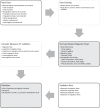Bilateral international migration flow estimates for 200 countries
- PMID: 31209218
- PMCID: PMC6572777
- DOI: 10.1038/s41597-019-0089-3
Bilateral international migration flow estimates for 200 countries
Abstract
Data on stocks and flows of international migration are necessary to understand migrant patterns and trends and to monitor and evaluate migration-relevant international development agendas. Many countries do not publish data on bilateral migration flows. At least six methods have been proposed recently to estimate bilateral migration flows between all origin-destination country pairs based on migrant stock data published by the World Bank and United Nations. We apply each of these methods to the latest available stock data to provide six estimates of five-year bilateral migration flows between 1990 and 2015. To assess the resulting estimates, we correlate estimates of six migration measures from each method with equivalent reported data where possible. Such systematic efforts at validation have largely been neglected thus far. We show that the correlation between the reported data and the estimates varies widely among different migration measures, over space, and over time. We find that the two methods using a closed demographic accounting approach perform consistently better than the four other estimation approaches.
Conflict of interest statement
The authors declare no competing interests.
Figures






Similar articles
-
Bilateral international migration flow estimates updated and refined by sex.Sci Data. 2022 Apr 14;9(1):173. doi: 10.1038/s41597-022-01271-z. Sci Data. 2022. PMID: 35422105 Free PMC article.
-
Indirectly Estimating International Net Migration Flows by Age and Gender: The Community Demographic Model International Migration (CDM-IM) Dataset.Hist Methods. 2015;48(3):113-127. doi: 10.1080/01615440.2014.999150. Hist Methods. 2015. PMID: 26692590 Free PMC article.
-
Quantifying global international migration flows.Science. 2014 Mar 28;343(6178):1520-2. doi: 10.1126/science.1248676. Science. 2014. PMID: 24675962
-
The Effects of Ethno-cultural Origin-Destination Interactions on Immigrants' Longevity.J Immigr Minor Health. 2022 Oct;24(5):1345-1366. doi: 10.1007/s10903-021-01245-0. Epub 2021 Sep 16. J Immigr Minor Health. 2022. PMID: 34529210 Review.
-
A Framework for Estimating Migrant Stocks Using Digital Traces and Survey Data: An Application in the United Kingdom.Demography. 2021 Dec 1;58(6):2193-2218. doi: 10.1215/00703370-9578562. Demography. 2021. PMID: 34751755 Review.
Cited by
-
Openness and COVID-19 induced xenophobia: The roles of trade and migration in sustainable development.PLoS One. 2021 Apr 8;16(4):e0249579. doi: 10.1371/journal.pone.0249579. eCollection 2021. PLoS One. 2021. PMID: 33831012 Free PMC article.
-
Effect of border policy on exposure and vulnerability to climate change.Proc Natl Acad Sci U S A. 2020 Oct 27;117(43):26692-26702. doi: 10.1073/pnas.2007597117. Epub 2020 Oct 12. Proc Natl Acad Sci U S A. 2020. PMID: 33046645 Free PMC article.
-
Climate change and international migration: Exploring the macroeconomic channel.PLoS One. 2022 Nov 16;17(11):e0276764. doi: 10.1371/journal.pone.0276764. eCollection 2022. PLoS One. 2022. PMID: 36383529 Free PMC article.
-
Demography: Fast and Slow.Popul Dev Rev. 2022 Mar;48(1):9-30. doi: 10.1111/padr.12464. Epub 2022 Jan 14. Popul Dev Rev. 2022. PMID: 35911176 Free PMC article.
-
Growing up and moving out: Migration and the demographic transition in low- and middle-income nations.Popul Stud (Camb). 2022 Mar;76(1):63-80. doi: 10.1080/00324728.2022.2034919. Epub 2022 Feb 23. Popul Stud (Camb). 2022. PMID: 35196469 Free PMC article.
References
-
- Ratha Dilip, Mohapatra Sanket, Scheja Elina. Impact of migration on economic and social development: A review of evidence and emerging issues. 2011.
-
- Dustmann Christian., editor. Migration. 2015.
-
- de Haas, H., Natter, K. & Vezzoli, S. Growing restrictiveness or changing selection? The nature and evolution of migration policies. Int. Migr. Rev. imre.12288, 10.1111/imre.12288 (2018).
-
- International Organization for Migration. Global Migration Indicators 10–1 (2018).
Publication types
MeSH terms
Grants and funding
LinkOut - more resources
Full Text Sources

